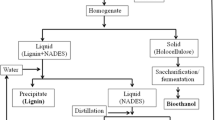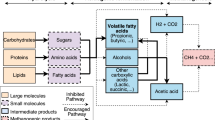Abstract
Distilled grain waste eluted from Chinese spirit making is rich in carbohydrates, and could potentially serve as feedstock for the production of bio-fuel ethanol. Our study evaluated two types of saccharification methods that convert distilled grain waste to monosaccharides: enzymatic saccharification and concentrated H2SO4 saccharification. Results showed that enzymatic saccharification performed unsatisfactorily because of inefficient removal of lignin during pretreatment. Concentrated H2SO4 saccharification led to a total sugar recovery efficiency of 79.0 %, and to considerably higher sugar concentrations than enzymatic saccharification. The process of ethanol production from distilled grain waste based on concentrated H2SO4 saccharification was then studied. The process mainly consisted of concentrated H2SO4 saccharification, solid–liquid separation, decoloration, sugar–acid separation, oligosaccharide hydrolysis, and continuous ethanol fermentation. An improved simulated moving bed system was employed to separate sugars from acid after concentrated H2SO4 saccharification, by which 95.8 % of glucose and 85.8 % of xylose went into the sugar-rich fraction, while 83.3 % of H2SO4 went into the acid-rich fraction. A flocculating yeast strain, Saccharomyces cerevisiae KF-7, was used for continuous ethanol fermentation, which produced an ethanol yield of 91.9–98.9 %, based on glucose concentration.





Similar content being viewed by others
References
Zhang J, Zhang WX, Wu ZY, Yang J, Liu YH, Zhong X, Deng Y (2008) A comparison of different dilute solution explosion pretreatment for conversion of distillers’ grains into ethanol. Prep Biochem Biotechnol 43:1–21
Tan L, Liu YH, Zhang WX (2011) Study on two-stage dilute hydrochloric acid saccharification of fermented grain waste. Food Ferment Technol 47(25–27):31
Zhou XB, Zheng P (2013) Spirit-based distillers’ grain as a promising raw material for succinic acid production. Biotechnol Lett 35:679–684
Yan SB, Li J, Chen XS, Wu JY, Wang PC, Ye JF, Yao JM (2011) Enzymatical hydrolysis of food waste and ethanol production from the hydrolyzate. Renew Energy 36:1259–1265
Zhang J, Zhang WX, Li SZ, You L, Zhang C, Sun CZ, Liu XB (2013) A two-step fermentation of distillers’ grains using Trichoderma viride and Rhodopseudomonas palustris for fish feed. Bioprocess Biosyst Eng. doi:10.1007/s00449-013-0887-5
Yang B, Wyman CE (2008) Pretreatment: the key to unlocking low-cost cellulosic ethanol. Biofuels Bioprod Bioref 2:26–40
Dagnino EP, Chamorro ER, Romano SD, Felissia FE, Area MC (2013) Optimization of the acid pretreatment of rice husks to obtain fermentable sugars for bioethanol productions. Ind Crop Prod 42:363–368
Tan L, Tang YQ, Nishimura H, Takei S, Morimura S, Kida K (2013) Efficient production for bioethanol from corn stover by pretreatment with a combination of sulfuric acid and sodium hydroxide. Prep Biochem Biotechnol 43:682–695
Laatikainen M, Heinonen J, Sainio T (2011) Modeling of chromatographic separation of concentrated-acid hydrolysates. Sep Purif Technol 80:610–619
Liu ZS, Wu XL, Kida K, Tang YQ (2012) Corn stover saccharification with concentrated sulfuric acid: effects of saccharification conditions on sugar recovery and by-product generation. Bioresour Technol 119:224–233
Sun ZY, Tang YQ, Iwanaga T, Sho T, Kida K (2011) Production of fuel ethanol from bamboo by concentrated sulfuric acid hydrolysis followed by continuous ethanol fermentation. Bioresour Technol 102:10929–10935
Sun ZY, Tang YQ, Morimura S, Kida K (2013) Reduction in environmental impact of sulfuric acid hydrolysis of bamboo for production of fuel ethanol. Bioresour Technol 128:87–93
Moe ST, Janga KK, Hertzberg T, Hagg MB, Oyaas K, Dyrset N (2012) Saccharification of lignocellulosic biomass for biofuel and biorefinery applications—a renaissance for the concentrated acid hydrolysis? Energy Procedia 2:50–58
Adney B, Baker J (2008) Laboratory analytical procedure: Measurement of cellulase activites. National Renewable Energy Laboratory, Golden
Van Soest PJ, Robertson JB, Lewis BA (1991) Methods for dietary fiber, neutral detergent fiber, and nonstarch polysaccharides in relation to animal nutrition. J Dairy Sci 74:3583–3597
Sluiter A, Hames B, Ruiz R, Scarlata C, Sluiter J, Templeton D, Crocker D (2011) Laboratory analytical procedure: determination of structural carbohydrates and lignin in biomass. National Renewable Energy Laboratory, Golden
Sluiter A, Hames B, Ruiz R, Scarlata C, Sluiter J, Templeton D (2008) Laboratory analytical procedure: Determination of ash in biomass. National Renewable Energy Laboratory, Golden
Kida K, Ikbal Sonoda Y, Kawase M, Nomura T (1991) Influence of mineral nutrients on high performance during anaerobic treatment of wastewater from a beer brewery. J Ferment Bioeng 72:54–57
Tang YQ, An MZ, Liu K, Nagai S, Shigematsu T, Morimura S, Kida K (2006) Ethanol production from acid hydrolysate of wood biomass using the flocculating yeast Saccharomyces cerevisiae Strain KF-7. Process Biochem 41:909–914
Cuvilas CA, Yang WH (2012) Spruce pretreatment for thermal application: water, alkali, and diluted acid hydrolysis. Energy Fuels 26:6426–6431
Balat M (2011) Production of bioethanol form lignocellulosic materials via the biochemical pathway: a review. Energy Convers Manag 52:858–875
Lynam JG, Reza MT, Vasquez VR, Coronella CJ (2012) Pretreatment of rice hulls by ionic liquid dissolution. Bioresour Technol 114:629–636
Yang CY, Sheih IC, Fang TJ (2012) Fermentation of rice hull by Aspergillus japonicus under ultrasonic pretreatment. Ultrason Sonochem 19:687–691
Chu CY, Wu SY, Tsai CY, Lin CY (2011) Kinetics of cotton cellulose hydrolysis using concentrated acid and fermentative hydrogen production from hydrolyzate. Int J Hydrog Energy 36:8743–8750
Iranmahboob J, Nadim F, Monemi S (2002) Optimization acid-hydrolysis: a critical step for production of ethanol from mixed wood chips. Biomass Bioenerg 22:401–404
Author information
Authors and Affiliations
Corresponding author
Rights and permissions
About this article
Cite this article
Tan, L., Sun, Z., Zhang, W. et al. Production of bio-fuel ethanol from distilled grain waste eluted from Chinese spirit making process. Bioprocess Biosyst Eng 37, 2031–2038 (2014). https://doi.org/10.1007/s00449-014-1178-5
Received:
Accepted:
Published:
Issue Date:
DOI: https://doi.org/10.1007/s00449-014-1178-5




